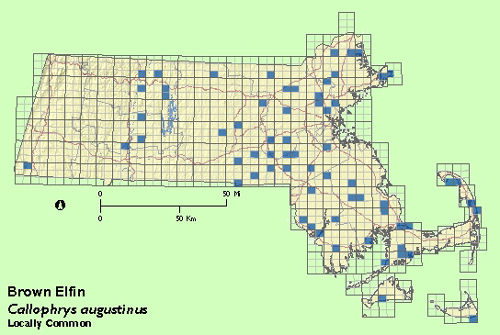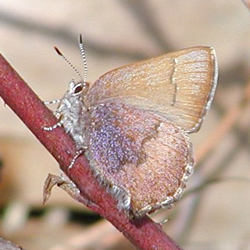Find a Butterfly
Brown Elfin
Callophrys augustinus
Named
W. Kirby, 1837

Taxonomy & Nomenclature
The genus name Incisalia and species name augustus also appear frequently in the literature.
Identification
Wingspan: 3/4 - 1 1/8". The plainest of our elfins, the lack of distinctive characters serving to distinguish it. The hindwing has a smooth outer margin with no trace of scalloping or "tails"; the underside is patterned in shades of rich mahogany brown with no trace of gray in the outer margins.
Distribution
A northern and mountain species, ranging from near the Arctic Circle in Alaska south through the Sierra Nevada to northern Baja California and through the Rockies to the Sierra Madre Occidental in northern Mexico, east through the northern tier of central states to southern Labrador and Newfoundland and south in the Appalachians to northern Georgia. Occurs throughout New England.
Status in Massachusetts
Locally common and even abundant in heathy barrens where its food plant is prevalent. The scarcity of atlas records in central and western Mass. may reflect a dearth of successional or stable heathlands and/or lack of field work in April and May when the species is on the wing. Maximum: 200+, No. Dartmouth (Bristol Co.) 1990.

Flight Period in Massachusetts
Mainly mid-April through May. Extreme dates: 30 March 1981 (8-10), Millis (Norfolk Co.), B. Cassie; 17 June 1986, Medford (Middlesex Co.), D. Schweitzer.
Larval Food Plants
Species in the heath family (Ericaceae), including especially the lowbush blueberries (Vaccinium angustifoilum [preferred in Massachusetts according to Schweitzer, pers comm.], and V.vacillans) and Black Huckleberry (Gaylussacia baccata). Other reported hosts include Bearberry (Arctostaphylos uva-ursi), Leatherleaf (Chamaedaphne calyculata), Rhododendron, spp.and Labrador Tea (Ledum groenlandicum- a rare bog species in Mass.); reported from Arbutus and Gaultheria outside of New England; known to oviposit on Sheep Laurel (Kalmia angustifolia), but larvae said to refuse it (Scott, 1986). Western races use a much broader range of food plants including members of the rose, knotweed, morning glory, buckthorn and lily families.
Adult Food sources
Many early blooming species such as heaths, cinquefoils, willows, cherries, and mustards. However, seen perched on ground or foliage far more often than at any nectar source.

Habitat
Areas of nutrient poor and acidic soils where its shrubby, ericaceous foodplants thrive. These include dry uplands such as the rocky "moorlands" of Cape Ann, fire ravaged "balds" and utility corridors in the interior and sand barrens on the coastal plain and Cape Cod as well as bogs and other acidic wetlands.
Life Cycle
EGG: Bluish green, becoming yellowish then white. OVIPOSITION: Eggs are laid singly on the flower buds of the food plant. LARVA: Apparently variable in color: usually bright green (but also "carmine red" fide H. Edwards in Scudder, 1889) and variably striped in white and yellow; covered with short hair; feeds mainly on the developing flowers and fruits (rarely on leaves). CHRYSALIS: Brown, spotted with black and covered with short hairs; ovoid, relatively smooth and shiny. PUPATION: In dry soil or leaf litter near the food plant. OVERWINTERING STAGE: Chrysalis. This is one of the first butterflies on the wing in early spring and is locally common, but is easily overlooked by anyone not familiar with its haunts and habits. Newly emerged males typically perch in sunny open spots on the ground or on raised perches such as boulders or twigs. In these situations their rich, but cryptic coloration make them all but invisible against a background of dead leaves or lichen covered rock. In the coolest weather they often seem to be half asleep, moving sluggishly and heeling aslant to absorb maximum heat. When disturbed or aroused by lepidopterist or fellow elfin, they turn into tiny rapidly fleeting shadows -- often returning however to a favorite perch to await passing females.
Account Author
Chris Leahy
Additional Information
Read more on this species at the North American Butterfly Association.



